Input interpretation

trans-decahydronaphthalene
Chemical names and formulas
![formula | C_10H_18 name | trans-decahydronaphthalene IUPAC name | decalin alternate names | 1, 2, 3, 4, 4a, 5, 6, 7, 8, 8a-decahydronaphthalene | t-decalin | trans-bicyclo[4.4.0]decane | trans-Decalin® | trans-perhydronaphthalene mass fractions | C (carbon) 86.9% | H (hydrogen) 13.1%](../image_source/1fd5ab8a49943bad2b331dfc2ce2011a.png)
formula | C_10H_18 name | trans-decahydronaphthalene IUPAC name | decalin alternate names | 1, 2, 3, 4, 4a, 5, 6, 7, 8, 8a-decahydronaphthalene | t-decalin | trans-bicyclo[4.4.0]decane | trans-Decalin® | trans-perhydronaphthalene mass fractions | C (carbon) 86.9% | H (hydrogen) 13.1%
Lewis structure
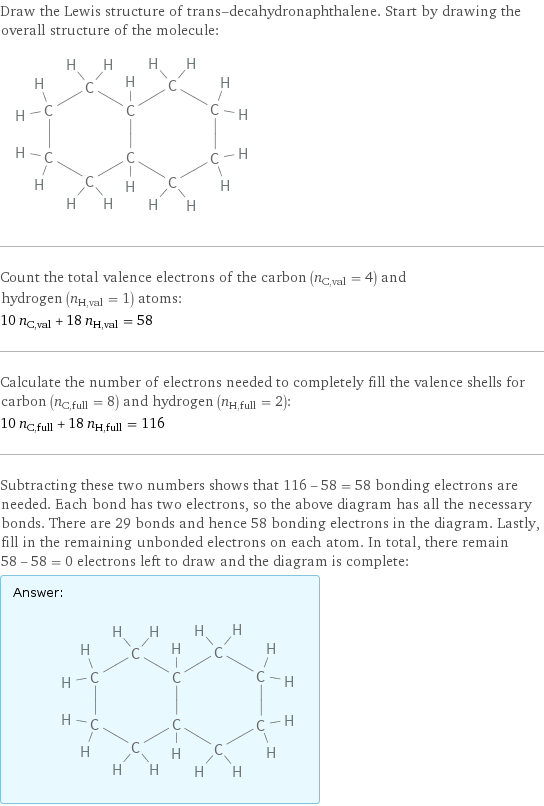
Draw the Lewis structure of trans-decahydronaphthalene. Start by drawing the overall structure of the molecule: Count the total valence electrons of the carbon (n_C, val = 4) and hydrogen (n_H, val = 1) atoms: 10 n_C, val + 18 n_H, val = 58 Calculate the number of electrons needed to completely fill the valence shells for carbon (n_C, full = 8) and hydrogen (n_H, full = 2): 10 n_C, full + 18 n_H, full = 116 Subtracting these two numbers shows that 116 - 58 = 58 bonding electrons are needed. Each bond has two electrons, so the above diagram has all the necessary bonds. There are 29 bonds and hence 58 bonding electrons in the diagram. Lastly, fill in the remaining unbonded electrons on each atom. In total, there remain 58 - 58 = 0 electrons left to draw and the diagram is complete: Answer: | |
3D structure
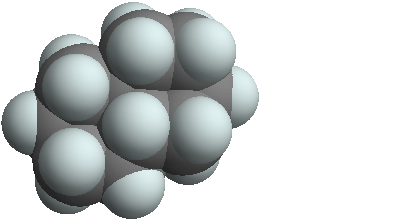
3D structure
Basic properties
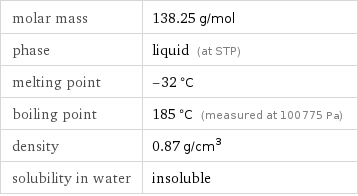
molar mass | 138.25 g/mol phase | liquid (at STP) melting point | -32 °C boiling point | 185 °C (measured at 100775 Pa) density | 0.87 g/cm^3 solubility in water | insoluble
Units

Liquid properties (at STP)
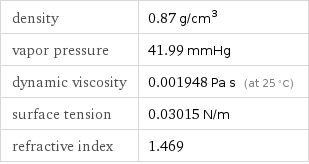
density | 0.87 g/cm^3 vapor pressure | 41.99 mmHg dynamic viscosity | 0.001948 Pa s (at 25 °C) surface tension | 0.03015 N/m refractive index | 1.469
Units

Thermodynamic properties
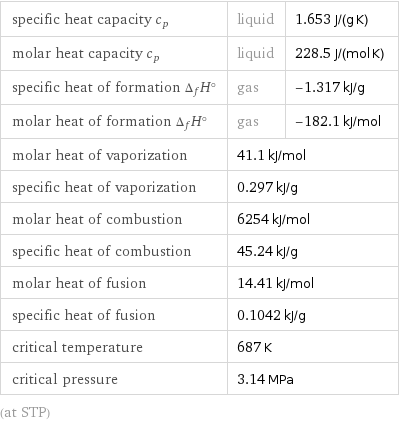
specific heat capacity c_p | liquid | 1.653 J/(g K) molar heat capacity c_p | liquid | 228.5 J/(mol K) specific heat of formation Δ_fH° | gas | -1.317 kJ/g molar heat of formation Δ_fH° | gas | -182.1 kJ/mol molar heat of vaporization | 41.1 kJ/mol | specific heat of vaporization | 0.297 kJ/g | molar heat of combustion | 6254 kJ/mol | specific heat of combustion | 45.24 kJ/g | molar heat of fusion | 14.41 kJ/mol | specific heat of fusion | 0.1042 kJ/g | critical temperature | 687 K | critical pressure | 3.14 MPa | (at STP)
Chemical identifiers
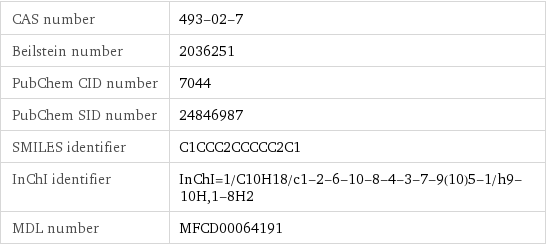
CAS number | 493-02-7 Beilstein number | 2036251 PubChem CID number | 7044 PubChem SID number | 24846987 SMILES identifier | C1CCC2CCCCC2C1 InChI identifier | InChI=1/C10H18/c1-2-6-10-8-4-3-7-9(10)5-1/h9-10H, 1-8H2 MDL number | MFCD00064191
NFPA label

NFPA label

NFPA health rating | 2 NFPA fire rating | 2 NFPA reactivity rating | 0
Safety properties
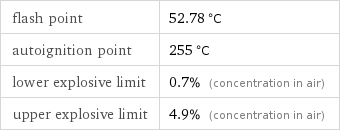
flash point | 52.78 °C autoignition point | 255 °C lower explosive limit | 0.7% (concentration in air) upper explosive limit | 4.9% (concentration in air)

DOT hazard class | 3 DOT numbers | 1993